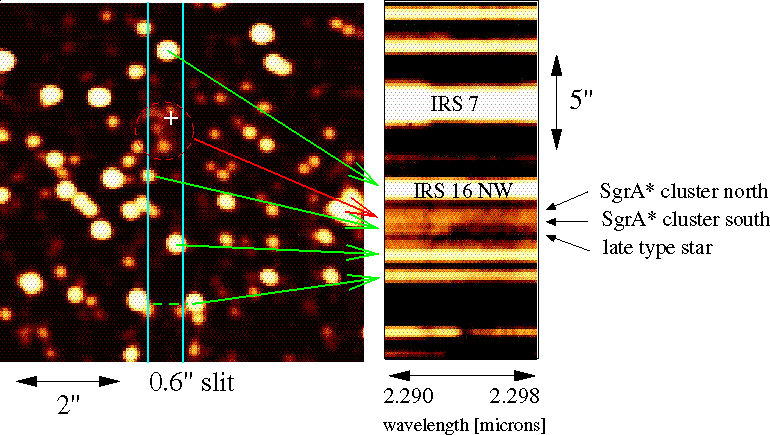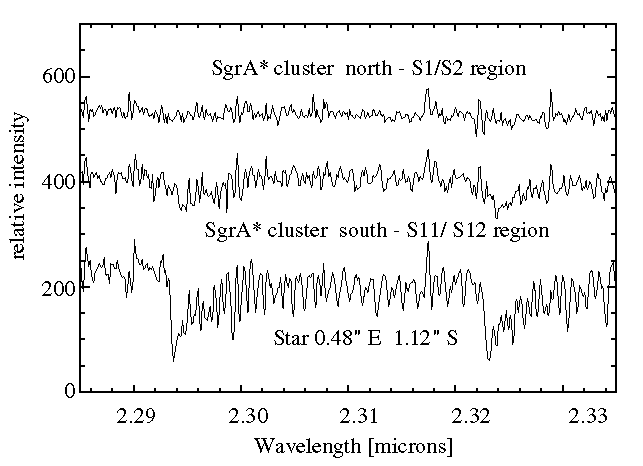Article - GCNEWS, Vol. 10, December 1999

 GCNEWS
GCNEWS
A Newsletter for Galactic Center Research
This Volume was edited by Angela Cotera & Heino Falcke
email: gcnews@aoc.nrao.edu

Volume 10, December 1999
- ARTICLE

[Home]
[New Abstracts]
[Newsletter]
[Newsflash]
[Articles]
[Conferences]
[Subscribers]
[Subscription]
[Submission]
[Next page]
[Previous page]
[Cover page]
VLT Spectroscopy of the Sgr A* Stellar Cluster
Andreas Eckart, Thomas Ott & Reinhard Genzel
(Max-Planck-Institut für Extraterrestrische Physik, Garching)
Abstract
We have obtained new near-infrared observations of the central stellar
cluster of our Galaxy carried out with the infrared spectrometer ISAAC
at the ESO VLT and the MPE speckle camera SHARP at the ESO NTT. With
ISAAC we used a spectral resolution of lambda/Delta
lambda ~ 3500 on the 2.058 micron He I, 2.165 micron Br-gamma
emission lines, and 2.29 micron CO bandhead absorption line. The data
demonstrate clearly that there is no strong CO bandhead absorption
originating in the northern part (S1/S2 area) of the central stellar
cluster at the position of Sgr A*. This makes it likely that the
K~14.5 fast moving objects are O9 - B0.5 stars with masses of 15
to 20 Msun. Weak CO bandhead absorption in the southern part
of the cluster (S10/S11 area) could be due to contributions from
neighbouring stars. We have also detected Br-gamma and He I line
emission at the position of the central stellar cluster which could be
associated with the 'mini-spiral' rather than with the Sgr A*
cluster itself. At the NTT we obtained another epoch to measure the
proper motion structure and variability of sources in the central
stellar cluster (see Ott, Eckart, Genzel 1999). The changes of source
positions are consistent with the proper motion velocities derived
from earlier epochs.

Figure 1:
Left: Speckle image reconstruction of the new June 1999 SHARP
data taken at the ESO NTT. Right: The central portion of a 5
minute, two dimensional spectroscopic exposure on the CO(2-0) bandhead
absorption line taken in ~0.3'' IR seeing with ISAAC on the ESO VLT
UT1 (ANTU). The position of Sgr A* (see Menten et al. 1997) is
indicated by a cross in the SHARP image. (Click here for a PostScript version.)
Introduction
The gas and stellar dynamics indicate the
presence of a large unresolved central mass
(Sellgren et al. 1990, Krabbe et al. 1995, Haller et al. 1996,
Eckart and Genzel 1996, 1997,
Genzel et al. 1996, 1997,
Ghez et al. 1998, 1999).
At its measured mass of about 2.6*106 Msun and
density (>=2*1012 Msunpc-3)
it cannot be stable and therefore is most likely present
in the form of a massive black hole (Maoz 1998).
Genzel et al. (1997) reported
first R=lambda/Delta lambda~35 speckle
spectroscopy measurements on individual objects in
the central ~1'' diameter
stellar cluster at the position of Sgr A*(IR).
In combination with other data this spectroscopic information can be used to
derive a lower limit to the mass associated with the compact radio source.
On 30 June and 1 July 1999 we obtained the
first ESO VLT UT1 (ANTU) NIR spectroscopic data of the Sgr A*
stellar cluster using ISAAC (Moorwood et al. 1998) at a spectral resolution of R~3500
on the 2.058 micron He I, 2.165 micron Br-gamma
emission lines, and the 2.29 micron CO bandhead absorption lines.
The combination of these spectroscopic data taken in excellent seeing
(0.3'' to 0.5'') and our new speckle image reconstructions
based on SHARP NTT data strengthen the case for a compact mass
and add to our understanding of the stellar population near the
center of the Galaxy.
Details of the observations are given in Eckart, Ott, Genzel (1999, A&A Dec.)
Here we summarize some of the first results.
Recombination lines
Our high spatial and spectral resolution data clearly show the
presence of Br-gamma and He I emission which is apparently spatially
coincident with the location of the Sgr A* central stellar cluster.
From our Br-gamma data we find a line width of <120 km/s and a
velocity gradient of about 35 km/s between the southern part
(S10/S12-region) and the northern part (S1/S2-region) of the cluster.
In both slit settings this line emission appears to be connected to
the more extended line emission over the remaining central cluster.
Combined with the small line width at any position in that region this
indicates that the emitting gas is not necessarily associated with the
Sgr A* stellar cluster. If the emission would be associated with the
cluster we would expect a larger line width due to the higher
gravitational potential indicated by the rapid motions of the stars.
However, broad and weak emission components could still be present at
very low flux levels.
CO absorption
Fig.1 shows our new speckle image reconstruction based on data taken
with the MPE speckle camera SHARP at the NTT in June 1999. In this
figure we compare the image with a section of the two dimensional
ISAAC spectroscopic exposure on the CO(2-0) bandhead absorption line.
One can clearly identify the individual sources that contributed to
the flux density in the 0.6'' slit. At the high angular resolution
(~0.3'' seeing) of the exposure one can distinguish between the
northern and southern part of the Sgr A* stellar cluster as well as a
star 1.12'' south of the the center with obvious bandhead absorption.
In Fig.2 we show the corresponding spectra There is only very weak
bandhead absorption on the northern Sgr A* cluster which is in
agreement with an expected contribution from the more extended
underlying stellar cluster. The bandhead absorption on the southern
part of the central stellar cluster is probably due to a significant
flux density contribution from late type stars in the immediate
vicinity. These new findings are in full agreement with our initial
results that we obtained via R~ 35 speckle spectroscopy measurements
on the individual objects S1, S2, S8, and S11. It also indicates that
most of the other S-sources - especially near the position of Sgr A* -
can not be stars with strong CO bandhead absorption.

Figure 2: Spectra of the
northern and southern part of the Sgr A* cluster as well as the late
type star 1.12'' south of the center. No strong CO(2-0) and CO(3-1)
bandhead absorption is measured towards the northern part containing
the fast moving sources S1 and S2. The spectra of the southern part
and the late type star have been shifted down by 150 and 300 units,
respectively. (Click here for a PostScript version.)
Our new data indicate that the mK~14.5 sources in the central Sgr
A* cluster are most likely moderately luminous (L~5,000 to 10,000
Lsun) early type stars. If these objects are on the main
sequence they would have to be O9 - B0.5 stars with masses of 15 to 20
Msun. Backer (1996, 1999) and Reid et al. (1999) have
shown that the proper motion of Sgr A* itself is < 16-20 km/s which
is close to a factor of 100 smaller than the velocity of the fast
moving stars in its vicinity. N-body simulations using 20
Msun as an upper limit of the mass distribution of these
high velocity stars result in a lower limit of 103 Msun
for Sgr A* (Reid et al. 1999, see also Genzel et al. 1999, 1997). The
corresponding mass density is larger than 1018
Msunpc-3, if this mass is enclosed within the
radio size of Sgr A* of \le 1 AU. At the measured mass and mass
density any dark cluster of stellar remnants (neutron stars, stellar
black holes), low luminosity stars (e.g. white dwarfs) or sub-stellar
objects would have a lifetime less than ~107 years. This
short live time in addition to the high compactness is inconsistent
with any currently known dynamical system. It appears that the most
probable configuration of the central mass concentration is a massive,
but currently inactive black hole (e.g. Quataert, Narayan, Reid 1999,
Falcke & Melia 1997, Blandford & Begelman 1999).
References
- Backer, D.C. 1996, in Unsolved Problems of the Milky Way, eds.
- Backer, D.C. & Sramek, R.A., 1999, Ap.J. 524, 805
L.Blitz and P.Teuben, Proc. of IAU 169 (Kluwer:Dordrecht), 193
- Blandford, R.D., Begelman, D.C., 1999, MNRAS 303, L1
- Eckart, A. and Genzel, R. 1996, NATURE 383, 415
- Eckart, A. and Genzel, R. 1997, MNRAS 284, 576
- Eckart, A., Ott, T., Genzel, R. 1999, A&A in press
- Falcke, H., Melia, F., 1997, Ap.J. 479, 740
- Genzel, R., Thatte, N., Krabbe, A., Kroker, H. and
Tacconi-Garman, L.E. 1996, Ap.J.472, 153
- Genzel, R., Eckart, A., Ott, T. and Eisenhauer, F. 1997, MNRAS 291, 219
- Genzel, R., Pichon, C., Eckart, A., Gerhard, O. and Ott, T.,
1999, submitted to MNRAS.
- Ghez, A., Klein, B., Morris, M. and Becklin, E., 1998, Ap.J. 509, 678
- Ghez, A., Morris, M., & Becklin, E.E.,
1999, in 'The Central Parsec of the Galaxy',
ASP Conference Series, Vol.186, p.18,
(eds.) H. Falcke, A. Cotera, W.J. Duschl, F. Melia, M.J. Rieke
- Haller, J.W., Rieke, M.J., Rieke, G.H., Tamblyn, P., Close,L.
and Melia,F. 1996, Ap.J. 456, 194
- Krabbe, A. Genzel, R., Eckart, A., Najarro, F., Lutz, D. et al.
1995, Ap.J.Lett. 447, L95
- Maoz, E. 1998, Ap.J. 494, L131
- Menten, K.M., Eckart, A., Reid, M.J. and Genzel, R. 1997, Ap.J. 475, L111
- Moorwood, A., et al. 1998, The Messenger 94, 7
- Ott, T., Eckart, A. and Genzel, R. 1999, Ap.J. 523, 248
- Quataert, E., Narayan, R., Reid, M., 1999, Ap.J. 517, L101
- Reid, M.J., Readhead, A.C.S., Vermeulen, R.C., Treuhaft, R.N. 1999, Ap.J. 524, 816.
- Sellgren, K., McGinn, M.T., Becklin, E.E. and Hall, D.N.B. 1990, Ap.J. 359, 112
[Next page]
[Home]
[New Abstracts]
[Newsletter]
[Newsflash]
[Articles]
[Conferences]
[Subscribers]
[Subscription]
[Submission]
Credits:
- Editors of this Volume: Angela Cotera & Heino Falcke
- The GCNEWS Logo
at the top of this page shows a 20cm radio map of the GC (Sgr A) made by Yusef-Zadeh & Morris.
- The GCNEWS newsletters, newsflashes and web pages are based on scripts originally developed by
Heino Falcke.
- Internet access for GCNEWS is currently sponsored by the
National Radio Astronomy Observatory in Socorro NM/USA.
Page currently maintained by
L. O. Sjouwerman.
File last modified on Monday 04 August 2003 [09:57 MDT].
[Home]
[New Abstracts]
[Newsletter]
[Newsflash]
[Articles]
[Conferences]
[Subscribers]
[Subscription]
[Submission]

 GCNEWS
GCNEWS
 GCNEWS
GCNEWS


